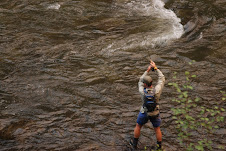 about three dogs that may fit the picture at the Martin household. Then I came across this scrawny but friendly African wild dog looking wiggling pup standing in the middle of her kennel trying to determine if she could trust me or not. About ten seconds later, she was pressing up against the chain link so I could pet her more. Then she sat back against the wall and waited to see who would come around and say "Hi" to her next. She had been in the kennel for about 5 - 8 days and had 2 - 3 p
about three dogs that may fit the picture at the Martin household. Then I came across this scrawny but friendly African wild dog looking wiggling pup standing in the middle of her kennel trying to determine if she could trust me or not. About ten seconds later, she was pressing up against the chain link so I could pet her more. Then she sat back against the wall and waited to see who would come around and say "Hi" to her next. She had been in the kennel for about 5 - 8 days and had 2 - 3 p eople interested in her. My Dad agreed with my selection of a possible dog and we filled out the paper work for possible adoption.
eople interested in her. My Dad agreed with my selection of a possible dog and we filled out the paper work for possible adoption.Two days later, we brought both Mom and Katja back to visit her and see how everyone would get along. Holly, recently changed to Molly, had just gotten out of surgery, so she was pretty mellow. Katja had greeted her long enough to get annoyed with "in your face" puppy behavior. Mom really took a liking to her as well. By the end of our visit, including extensive paper work, she had officially become ours.
Molly has been at the house for almost a full week now and she is getting along
 pretty well. Katja maintained her distance during this time and whenever annoyed would retreat to my bedroom upstairs to escape. Recently, they have been playing more inside and out. Poor Molly gets rolled over and over again as they tear around the yard. They have developed a mutual respect for each other. Molly has learned how to interact with Katja without getting snapped at and Katja has been much more receptive to Molly's p
pretty well. Katja maintained her distance during this time and whenever annoyed would retreat to my bedroom upstairs to escape. Recently, they have been playing more inside and out. Poor Molly gets rolled over and over again as they tear around the yard. They have developed a mutual respect for each other. Molly has learned how to interact with Katja without getting snapped at and Katja has been much more receptive to Molly's p uppiness during the last couple of days.
uppiness during the last couple of days.Dad loves the dog because of her loyal nature and her level of intelligence. She now responds to "Molly" and will seat, stay, and heal pretty consistently. She also has a mellow nature and spends a lot of time either curled up in front of the fire place or stretched out in the sunniest part of the house napping or just observing the mindless interactions and goings on of us humans. She is learning that her kennel is where she sleeps at night and freely goes in on her own accord now. During the night, she still wakes up and starts whining and asking to get some attention. A quick reprimand, a little tough love, and she usually quiets down again. She still does have the occasional accident in the house, which is also troubling to my Dad. It's been 12 years since he has had to train a puppy. I won't say that "you can't", but it is "hard to teach old dogs new tricks." They do like to take a little nappy nap time each afternoon. Dad's best friend.





























